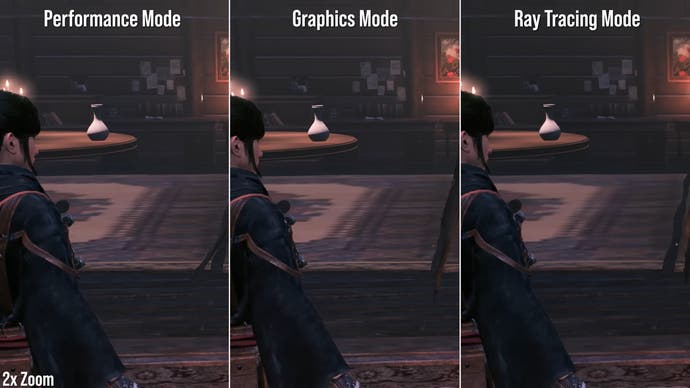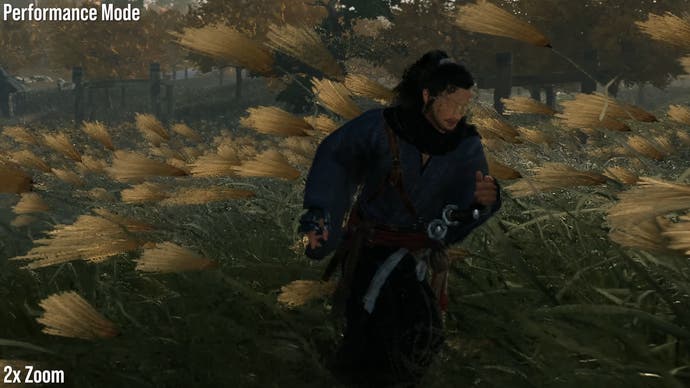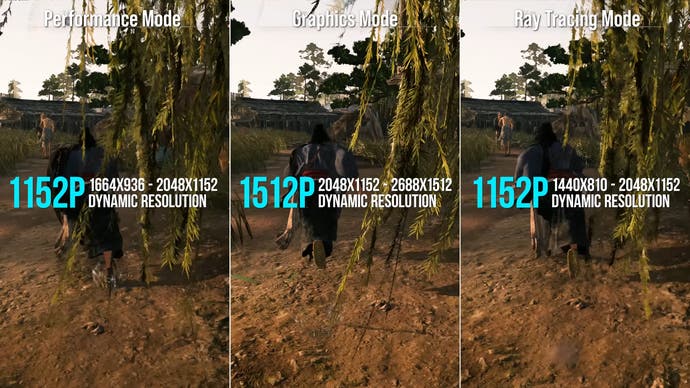Rise of the Ronin is an open-world samurai action RPG, and perhaps developer Team Ninja's most ambitious project to date. Building on the same in-house technology that powered Wo Long: Fallen Dynasty and Stranger of Paradise, the pure focus on PlayStation 5 development makes the project particularly tantalizing in what has become a prolonged cross-generation era. To that end, fully open world streaming is incorporated into the engine plus ray-traced reflections.
Despite these engine breakthroughs, Team Ninja has a huge challenge in following 2020's Ghost of Tsushima, Sucker Punch's open-world samurai action game which set a high bar for visual quality despite its cross-gen release. How does Rise of the Ronin fare in comparison, and which of its three graphics modes are the best way to enjoy the game?
The good stuff first: Rise of the Ronin takes the winning Souls blueprint for its combat, with a particular focus on counterattacks – much like Wo Long: Fallen Dynasty. The more counters in a row you nail, the lower the opponents' stamina gauge falls until they're left open to a finishing move. It's brilliantly executed, and the tight action – together with a wealth of weapons and the ability to quickly switch characters and styles – make for a satisfying challenge.
Rise of the Ronin – PS5 Tech Review – A Superb Action RPG… But Can It Sustain 60FPS?
Zooming out, all of this combines with a broad open-world design that recreates mid-19th century Japan. As a wandering ronin you take on quests, with the story branching out depending on which allegiance you pick. The quest structure is more Assassin's Creed than Dark Souls though, with objective markers filling the map and tools like horses, grappling hooks and gliders available to help you get from A to B quickly.
Perhaps unsurprisingly, while Rise of the Ronin's combat, story and RPG elements are all Team Ninja at its very best, the open world is less polished in its delivery. Especially compared to the likes of Ghost of Tsushima on PS5, it seems the addition of world steaming isn't always an elegant fit for the engine.
On the plus side first: character models are often beautifully detailed. We get high quality shadows, adjusting with the changing time of day to give a convincing day-night cycle. Also, the linear missions put some beautiful effects in view, whether that's snow physics allowing you to procedurally leave a trail on the ground or volumetric smoke filling the cabin of the Black Ship. Specific areas also use ray-traced reflections in the RT mode, falling back to screen-space reflections (SSR) in the other modes. Sadly, RT reflections are quite rare, with larger water bodies and varnished interior floors opting for SSR instead in all modes.


That brings us to a few of the negatives. Firstly, foliage, shadow maps, lighting and NPCs can all pop in close to the camera regardless of mode, especially in city areas or while riding on horseback. Textures also use a low-grade anisotropic filtering setting, blurring surfaces at the typical viewing angle. Every one of the game's modes uses it – and it resembles a 4x AF setting we'd get on PC.
All of this lends the game distinctly last-gen look at times, which is compounded by image quality and frame-rate issues. In the performance and RT modes, most open areas render at a native resolution at or below 10808p, creating a soft result. AMD's FSR2 is used to upscale to 4K, but this produces visible artifacts on moving elements like swaying foliage. No mode on PS5 is capable of perfectly locking to 60fps either, although some modes get much closer than others.
We already mentioned the three modes, which encompass a 60fps performance mode, 30fps graphics mode and 30fps RT mode. Up front, I'd recommend the performance mode, as the graphical uplift from the other modes simply isn't worth the frame-rate penalty. And although a seperate 30fps cap option is offered for the ray tracing and graphics modes, it produces even frame pacing. In fact, this 30fps cap kicks in for cutscenes even on the 60fps performance mode, so you'll have to deal with the judder regardless of your mode selection.
Manage cookie settings
On the surface all three modes run with identical settings, in terms of world detail, textures, lighting, and shadows. Many of the core building blocks of the world are precisely matched. Instead, the graphics mode offers an upgrade to image quality, as it runs at a dynamic 1512p. That's a visible step up over the dynamic 1152p target used for the performance and RT modes, although in truth all modes rarely hit their target resolution. The graphics mode normally hits 1152p, the RT mode manages 810p to 900p and the performance mode is often 936p. In short, for the sharpest image and fewest FSR2 artefacts, the quality mode is your best bet – but you'll need a VRR display in place to deal with its many sub-60fps drops.
Reflections are also handled differently across modes. The RT mode of course uses RT reflections in places – but, bizarrely, an SSR technique is used for a majority of the game's rivers, oceans and even floors anyway. In the end, the occasional use of RT for reflections in spots like the tutorial is impressive, but such areas are too rare to be worth the image quality and frame-rate penalty. I also looked for ray-traced global illumination (RTGI), ray-traced ambient occlusion (RTAO) or ray-traced shadows, but didn't find any signs of them – so they're either not included or extremely subtle. It is worth noting that the graphics mode offers the best screen-space reflection quality of the three modes – resulting in sharper mirror image than the other two.
This makes for a peculiar set of options to have, with an image quality boost and better SSR in the graphics mode, and the occasional use of RT reflections in the ray tracing mode, but beyond that there isn't much to split the three.


There are performance differences too. The 60fps performance mode obviously enjoys the best frame-rates, given its lower internal resolution and fewer graphical features, but it's not quite a locked 60fps in practice. Still, across the first six hours frame-rates typically only drop into the 50s, with a ~45fps nadir when flying over populated areas. These drops often accompany new assets or effects streaming in, or as the camera moves and dynamic resolution scaling has to react. This frame-rate is within the range of a VRR display, but for those without VRR support, expect to see judder around stress points and occasional lurches elsewhere. Still, the performance mode is the best way to enjoy Rise of the Ronin's timing-sensitive combat, as landing a vital counter depends on this smooth visual feedback.
Next along is the graphics mode – easily the most taxing option of the trio. Locking to 30fps provides a solid average frame-rate, but the uneven frame-pacing rather ruins the experience. Unlocking allows for better performance in less taxing areas, from 35-50fps, with the resolution dynamically adjusting to keep us close to 45fps. VRR compatible displays will struggle to fully turn this around, as at the extremes we're outside the ideal range and you'll notice judder regardless. So whether this huge frame-rate hit is worth running at a higher resolution – at up to 1512p – and the better SSR setting is entirely up to you.
The final option then is the ray tracing mode. In effect its frame-rate falls between the other two modes: just below the performance mode, but often above the graphics option. The undoing of this mode is that actually encountering its RT reflections results in worse performance; looking at a pond is enough to see performance dip into the 30s and low 40s, compared to a solid 45fps at a higher resolution in graphics mode or 60fps in performance mode.


The ray tracing mode is otherwise respectable. Emerging into the Yokohama region for the first time, you get close to the 60fps line of the performance mode, often in the high 50s – good enough for VRR – and huge segments of combat or exploration often run at 60fps, albeit with one-off dips on occasion. Things fall down in cities though, where drops to the mid 40s are possible. Given that performance is therefore quite variable and the relatively few uses of RT come with performance hits, we'd still recommend the 60fps performance mode overall, given its more consistent performance and the nature of Rise of the Ronin's gameplay.
That's the lowdown on Rise of the Ronin then. As an open-world effort from Team Ninja, the results are mixed – but the winning combat, characters, and RPG systems add huge value to the package. The main frustration is that a perfect 60fps is out of reach. Its performance mode is the best option of the bunch, but still suffers from drops and a blurry image to boot. Meanwhile, the graphics mode is the visual purist's best option. The resolution is boosted in exchange for a wildly variable frame-rate – but again, pairing that with a 30fps cap gives you uneven frame-pacing. There's no ideal solution really; the 60fps performance mode makes most sense, even if it doesn't flatter the presentation of the open world.
Speaking to the game itself, it's clear Sucker Punch's superb Ghost of Tsushima is a very hard act to follow for any open-world samurai action. Even with the four year gap between the two games – plus the dedicated PS5 development – Rise of the Ronin doesn't always show a great generational leap for it. The game's visuals impress at times on the open road, but that's in part owed to the inherent beauty of the Japan setting, and the fascinating time in history it's trying to recreate. Working against that is the game's image quality, variable frame-rate, and pop-in – all of which at times distract from the spectacle. More often than not, it's the linear missions and interiors that showcase the game's tech better. Contained areas play to Team Ninja's strengths, in offering detailed playgrounds that set the stage for precise, challenging combat. And the team's pedigree here is truly clear to see. For that alone, for fans of Ninja Gaiden or Wo Long Dynasty, it's worth seeing past the game's rougher edges.
#Rise #Ronin #PS5 #tech #review #good #game #marred #technical #challenges